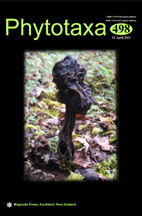Abstract
Rhipsalis Gaertner (1788: 138) belongs to Cactaceae Juss., which is among the major taxonomic groups including the highest numbers of threatened species in the world (Goettsch et al. 2015). The center of diversity and endemism of this genus is in the Atlantic Forest in Brazil, a world hotspot of biodiversity (Myers et al. 2000). This forests harbors 5% of all flowering plants species on the planet (Stehmann et al. 2009), including a high diversity of vascular epiphytes. Cactaceae is the sixth most expressive family in terms of number of epiphytes in the Atlantic Forest (2.2% of all vascular epiphyte species at the domain; Freitas et al. 2016) and Rhipsalis is the largest genus of epiphytic cacti (40 species according to Calvente 2012), highlighting the importance of this genus amongst the global epiphytic flora.

